Here’s how to make the most of five days in Bulgaria with this Bulgaria itinerary. Start your journey in the capital, spending your days in the capital soaking up its rich history and vibrant culture.
Sofia and Plovdiv are must-visits, each city boasting a lot to offer, from historic sites to buzzing nightlife. Rila Monastery is one of the best places to visit and a spiritual jewel of the country.
With international airports facilitating your arrival, embarking on this adventure through Bulgaria’s most captivating sights is a breeze.

Bulgaria has so much to offer. The country is a natural bridge between East and West, providing natural beauty and cultural origins from both regions. This becomes evident when you arrive and find yourself in the nation’s capital, Sofia.
Suppose you only have five days to spend in Bulgaria. In that case, the following suggestions are truly worthwhile highlights from my own time in Bulgaria (also, check out these relaxed, small-town itineraries).
Experience a taste of Sofia’s rich architecture and cultural history, and enjoy traveling the open roads for short drive day trips exploring further afield to find yourself in awe and experience Bulgaria’s rich history, wonders, and beauty. What will you decide?
Skip Ahead To My Advice Here!
5 Days In Bulgaria – Start In Sofia
Your Bulgaria itinerary will most likely start in Sofia if you arrive by plane. Hiring a car or taxi from the airport is only a 20-minute drive to Sofia city center. Alternatively, a train service takes just under half an hour. For others, traveling by bus is an option, as many bus service providers have connections from other Eastern European cities that travel to Sofia.
There’s a lot to see and appreciate in and around the city center, and it is best experienced on foot. However, traveling the subway is also an option and an exciting experience in itself. The metro and train services run frequently; however, there is a lack of signage in the metro/train stations to guide you to the right platform.
Where To Stay In Sofia – The Largest City In Bulgaria
Planning A 5 Bulgaria Travel Itinerary
Day 1 Of Your 5 day Bulgaria Itinerary: Sofia
So, you are now in Bulgaria spend your first day exploring Sofia, the capital city of sofia.
Here are a few highlights in the heart of sofia.
Alexander Nevsky Cathedral
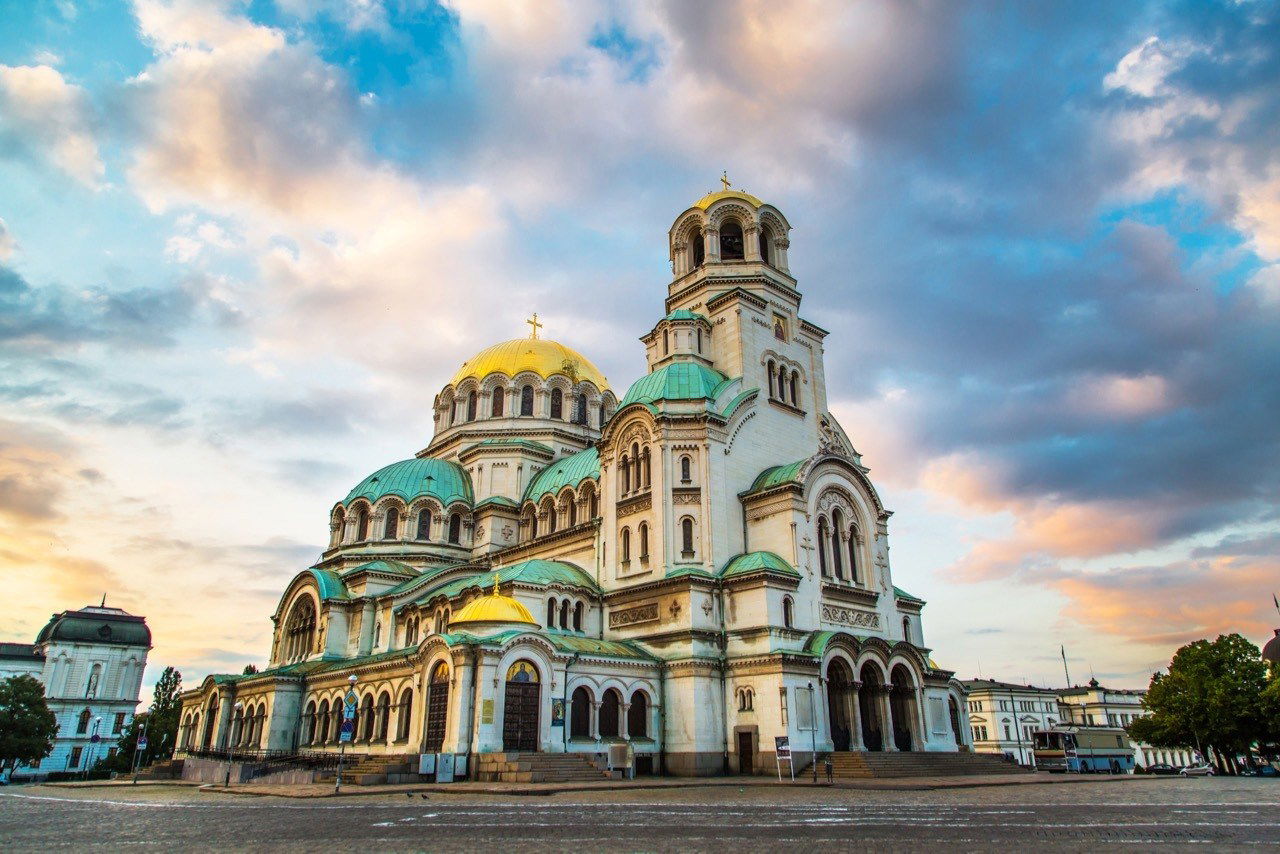
The prominent domed Alexander Nevsky Cathedral stands as a noteworthy religious landmark in Bulgaria and is one of Europe’s most significant Orthodox Christian Cathedrals. The prominent domed Alexander Nevsky Cathedral stands in the heart of the city center. Construction of the Cathedral commenced in 1904, with completion in 1916 in honor and memory of the thousands of lives lost throughout the rebellion against the Ottoman Empire from 1877 – 1878.
The Byzantine religious architecture from the 11thcentury is adorned with ornate gold leaf domes and provides sanctuary for 5000 worshippers. It’s worth stepping inside the dimly lit interior to admire the decorative work of high columns and detailed frescoes.
Church of St Nicholas, the Miracle Maker – ‘Russian Church’
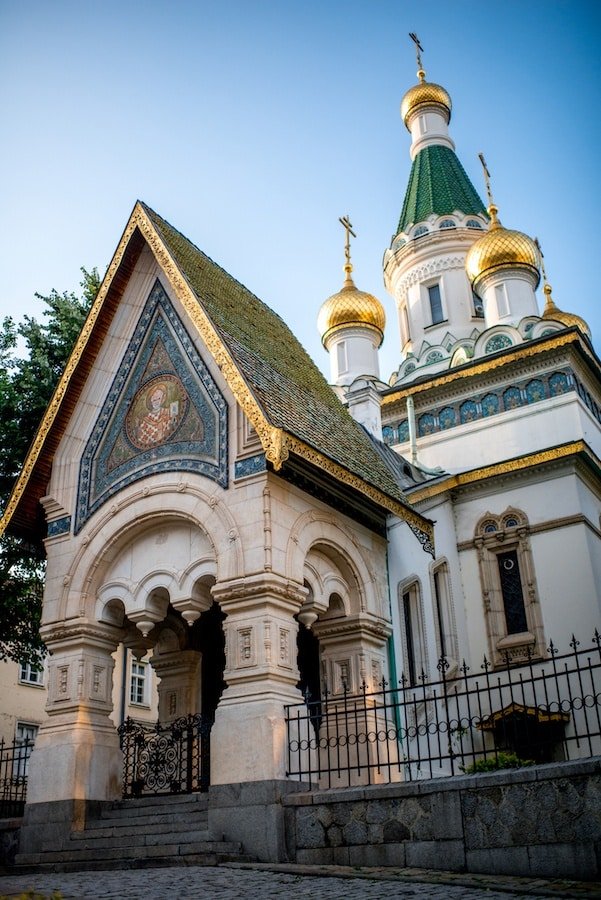
This sweet and ornately designed and colored church, aptly named the ‘Russian Church,’ was built following Bulgaria’s liberation and the end of Ottoman rule.
The 17-century Moscow architecture-designed church has five golden domes and symbolizes light in itself. At the onset of WWII and seeing the Bulgarian Monarchy being overthrown by the Russian Communist Party, leading to nearly 50 years of Communist rule in Bulgaria. During this time, Bulgarian people were unable to attend any church services.
However, the foresight of the then-presiding Bishop, Vladyka Seraphim, worked hard and formed a committee that gained him support for those in need. During his sermons, he appealed to parishioners to donate to support others who required food, health services, and housing, thus becoming known for his gift of being a ‘miracle maker.’
Ivan Vazov National Theatre
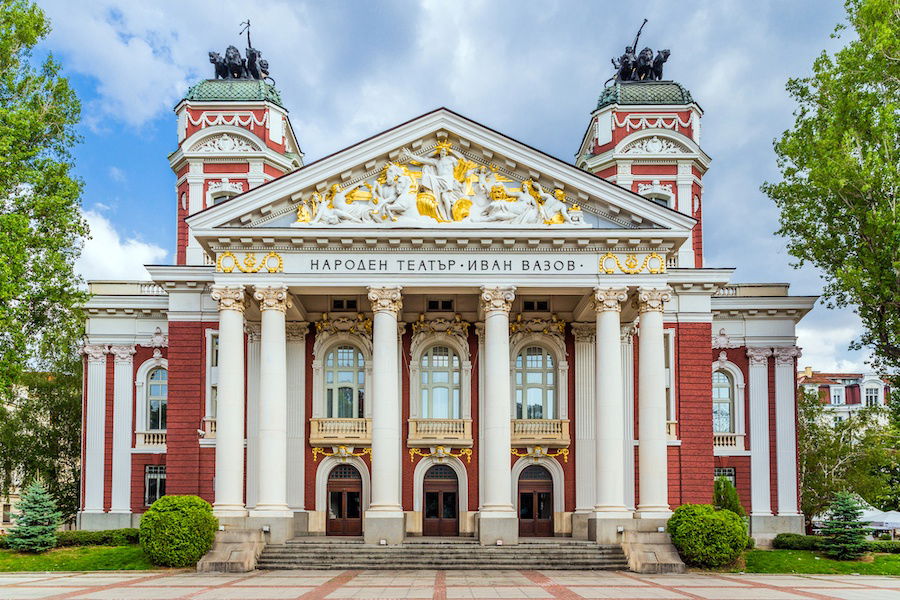
Amongst the many beautiful architecturally designed buildings in Sofia, one that is striking is the Ivan Vazov National Theatre. Bulgaria’s national theatre.
You’ll find the Ivan Vazov National Theatre, located and adjourning the large leafy treed City Gardens. The theatre’s neoclassical design is the oldest in the country. There is a choice of cafes; however, why not grab yourself a takeaway option and relax in the gardens listening to the sounds of the dancing ballerina water fountain?
As you roam the inner city center that is outlined by yellow-painted cobbled stone pavements and the wider city center, take note of the many other beautiful architecturally designed buildings, like the Sofia University, Sofia City Art Gallery, Central Military Club, National Gallery of Theatre and Film that was formerly a Palace and too many more to list.
Also, note the many varied statues, monuments, and art structures dotting the city center. You’ll also find several open green spaces and public parks throughout the city center – a very inviting place to be.
Where To Eat In Sofia
For a tasty breakfast, look no further than a local bakery. Many sell freshly baked traditional Bulgarian pastry, Banitza, a traditional breakfast snack.
Made In Blue
For a seasonal taste sensation, make your way to ‘Made In Blue’ on Yuri Venelin 6, in the heart of the city. The unique retro and artsy style décor brings new life to restoring an old traditional abandoned home, with the buildings, a namesake blue exterior, and a delightful terrace garden.
The cafés quirky and quaint, and the welcoming atmosphere feels like home. Yet, you won’t find traditional Bulgarian, Italian, French, or Turkish food. The menu offers a mouth-watering selection of tasty homemade dishes from the Middle East and other in-season salads.
Diwan Iraqi Restaurant
The aroma of Arabic spices fills the air as you make your way through Sofia’s largest, busiest, and 140-year-old market, Zenski Pazar (Ladies Market), in Sofia’s Arabic neighborhood –Car Simeon.
After roaming the local markets and experiencing all the market has to offer, you’ll no doubt feel a little hungry. Located on a corner close to the market’s main thoroughfare, you’ll find a more traditional Middle Eastern restaurant, Diwan Iraqi restaurant, just off a small lane.
It’s a simple menu in a simple setting and good value delicious food.
Confetti Gelataria
And to satisfy your sweet tooth, make a stop at Confetti, a fabulous traditional homemade Italian Gelataria, and restaurant. The restaurant offers a wide choice of healthy meals in a relaxed atmosphere. They offer an extensive selection of traditional Italian gelato flavors to seriously decadent ice-cream creations that are more like a work of art.
Strawberry-topped salted caramel gelato with amaretto biscuits and a swirl of amaretto liquor. Hmmm, mmm, treat your taste buds.
Now it’s time to explore further afield, and a great way to travel in Bulgaria is by car. You can get to these sights with a vehicle – all of them are very easy day trips from Sofia.
2nd Day In Bulgaria: Rila Monastery – Rupite Hot Springs- Rupite Village – St Petka of Bulgaria Memorial Temple
These locations are approx. 1 hour apart. You have time to spend a few hours at each location.
Rila Monastery
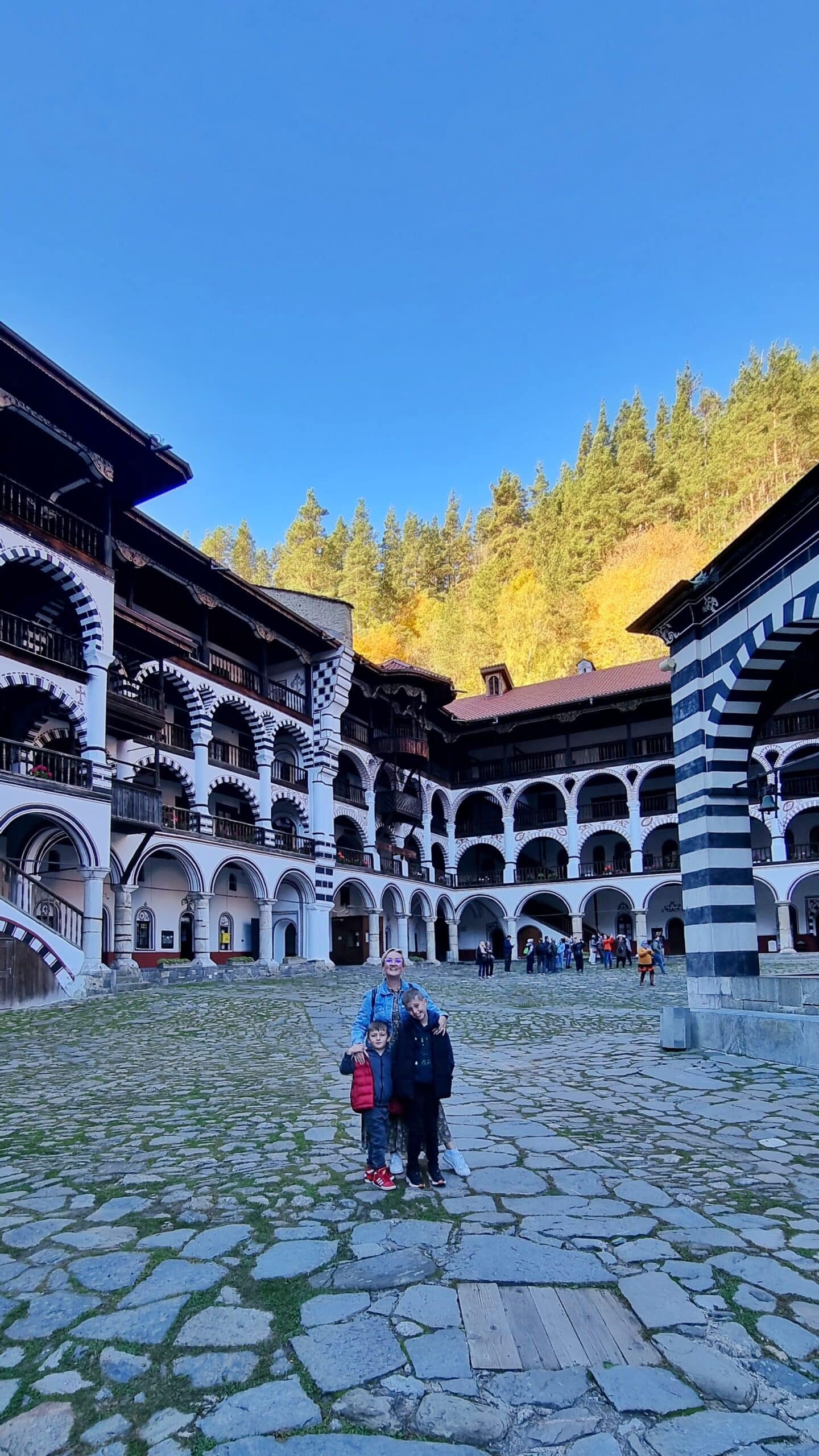
Staying in Sofia as a base provides an excellent opportunity to experience several other different and diverse regions within Bulgaria. Bus services are available (with much longer travel times) and guided day tours are also available. On my Bulgaria itinerary, I made all of these day trips noted below in a hire car from Sofia.
Take a 1 ½ hour drive south towards the Bulgarian/Greek border along the A3, then exit towards and through the lush green Rila Mountains to visit Rila Monastery. The largest Orthodox Monastery in Bulgaria.
Initially, the monastery was built as an education center for students following the religious teaching by the hermit St. John of Rila. Today it is an important cultural and spiritual center of the Balkans and is pictured on Bulgaria’s 1 lev banknote.
Rupite Natural Hot Springs
A car is the only accessible means to visit these lesser-known natural open-air hot springs (aside from local knowledge). Around a 1 ½ hour drive south towards the Bulgarian/Greek border along the A3 and following signs to Petrich.
Then note signs to the Ancient City of Heraclea Sintica. The natural springs are located approximately 2 km from the village of Rupite at the foot of Kozhuh Mountain, an extinct volcano.
RupiteVillage – St Petka of Bulgaria, Memorial Temple
In the area, take a 5 min drive from the natural hot springs and visit the Memorial Temple, St Petka of Bulgaria.
The non-traditional designed church was built within the grounds now known as the “Vanga Complex” in 1994 from money provided by the prophet Vanga, born as Vangeliya Gushterova. During the prophet’s childhood years, local legend claims that she lost her sight in a storm and subsequently had her first vision, unlocking what is said to be her remarkable prophecies. Originally from the small village of Rupite, it is also claimed that the prophet found the area around the natural hot springs provided a healing energy source that enhanced her intuitive insights.
The prophet Vanga is well known by the Bulgarian people, and the St Petka Memorial Temple attracts thousands of worshipers seeking solace. Together with many tourists from other countries worldwide, visit the small museum showing photos of the prophet’s life and her modest home where she lived her last years and meet with people seeking her help. As you walk the grounds, enjoy the outdoor garden areas, relax in one of the garden’s gazebos, or picnic on the manicured grass lawns.
The prophet’s grave can be seen at the foot of the bell tower adjacent to the church.
Place To Visit On Day 3: Plovdiv
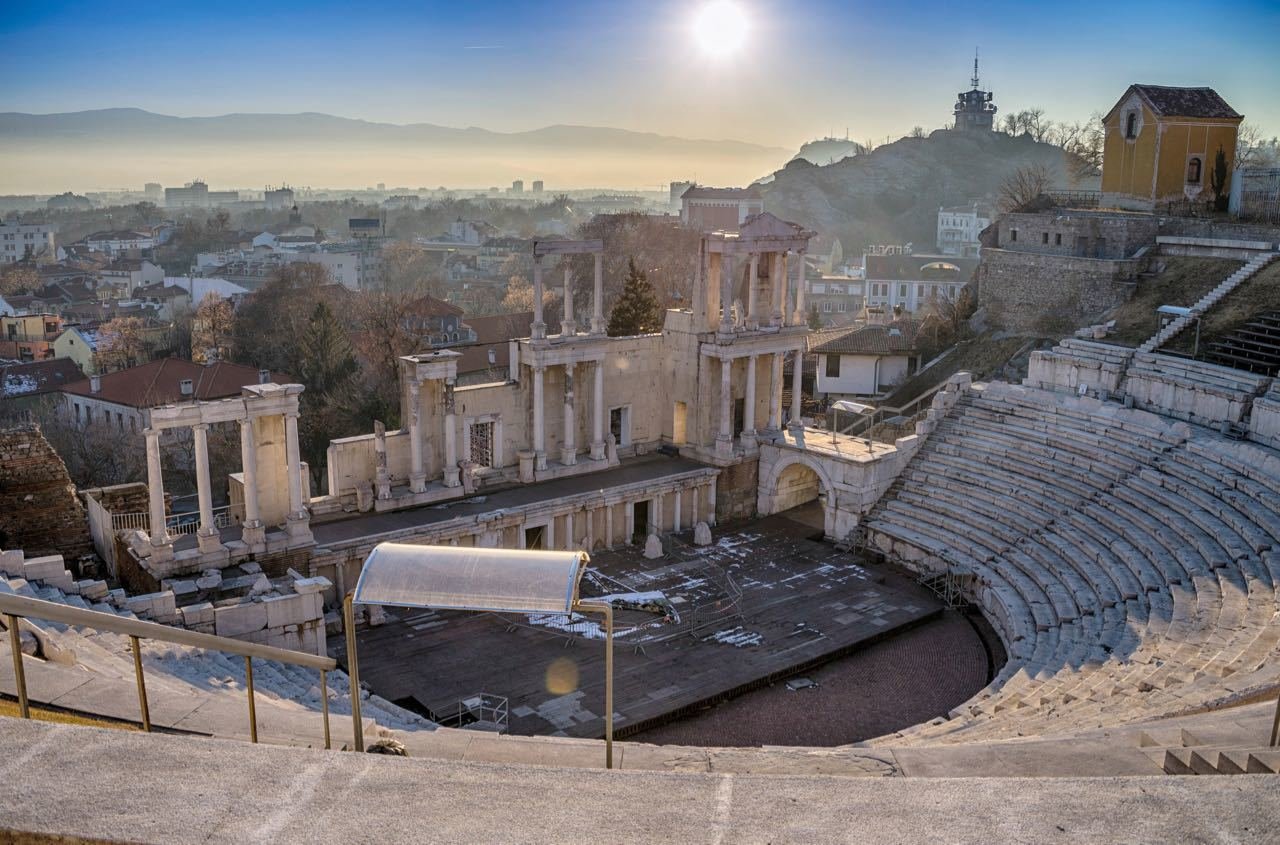
Well worth taking a scenic drive to experience Plovdiv’s beauty and spend a whole day here (this is the longest day of the three days).
1 ½ hour from Sofia, in the western region of the Upper Thracian Valley, you’ll find one of the oldest cities in Europe and Bulgaria’s second-largest city – Plovdiv.
Plovdiv’s old center is rich in history and was titled the European Capital of Culture in 2019. Evidence shows that early habitation dated back to the Stone Age and was found in the Bronze and Iron Ages. Around 400BC, the people known as Thracians founded the land of modern Plovdiv under the name Eumolpius.
The proceeding centuries show tumultuous change, change, and more change with Greek state rule, Roman rule, Slavic settlement, Byzantine rulering Greek Constantinople, various rebellious uprisings, and defeats of Ottoman rule. Change continued with Bulgaria coming under Russian communism following WWII and the preceding 45 years until the collapse in 1989. In 2004 Bulgaria joined NATO and later joined the EU; however, it retained its national currency – the Bulgarian Lev.
With the many changes between friends and foes, Plovdiv is now home to a cultural mix left by the various ruling occupations. Today, the city’s charm, open public parklands, and a blend of Empire-ruled architecture throughout its historic past contribute to the city’s prosperity.
With its unique mix of cobbled stoned streets, Plovdiv Old Town, lined with 150-year-old beautifully restored, painted residences, and its well-preserved Roman Ancient Stadium, together with Dzhumaya Mosque, oozes a charming, charismatic, and calming feel.
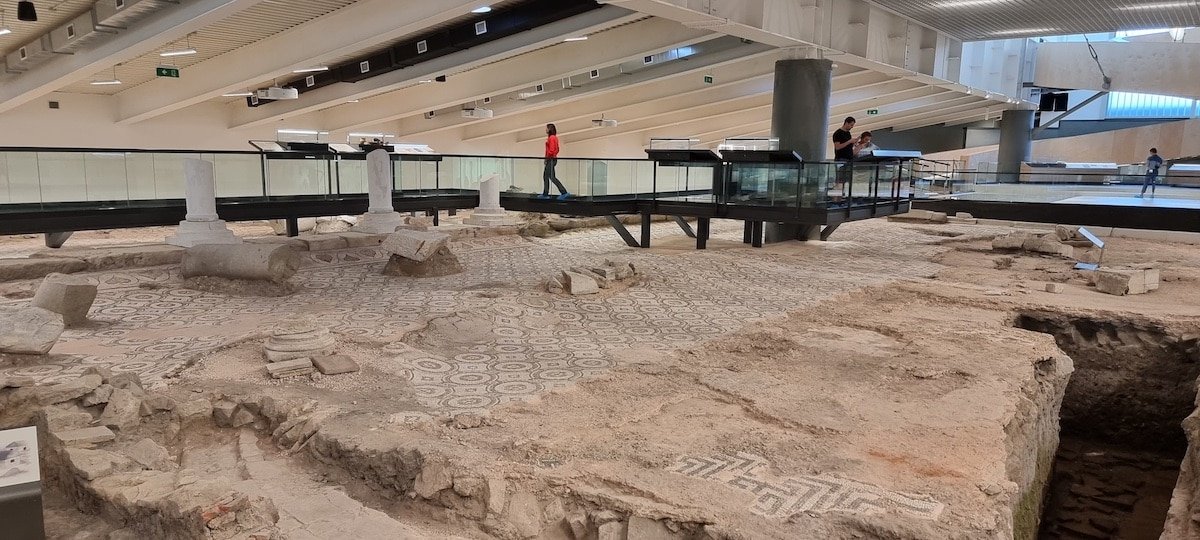
The Ancient Roman Stadium runs under the main shopping street of the Old Town. Built with fourteen tiers of marble blocks to provide seating for up to 30,000 spectators during the 2ndcentury, it is one of the most notable landmarks in the city center.
Across from the ancient stadium in the heart of the pedestrian zone stands Dzhumaya (translated as Friday) Mosque, one of the oldest and most prominent in the Balkans. The Mosques’ pink painted minaret stands at a towering 23 meters, and the dusky pink brickwork indicates the Mosque was built during the 14thcentury.
The Roman Stadium, the Dzhumaya Mosque, and other ornate architecturally designed buildings nearby make for a very contrasting 360°view.
Plovdiv’s Old Town Center has an array of places to eat, and like other cities and larger townships across the country, it has lovely outdoor public parklands. Sit a while and watch the locals playing board games, or enjoy the surroundings of the lush green lawns and shady trees.
Day 4 Around Bulgaria: Bansko (Old Town & Ski Resort) – Blagoevgrad Province Day Trip
Next in your Bulgaria itinerary is to take in the sights of the Old Town, experience lunch in a local/traditional mehana, and perhaps take an opportunity to treat oneself to a day spa treatment.
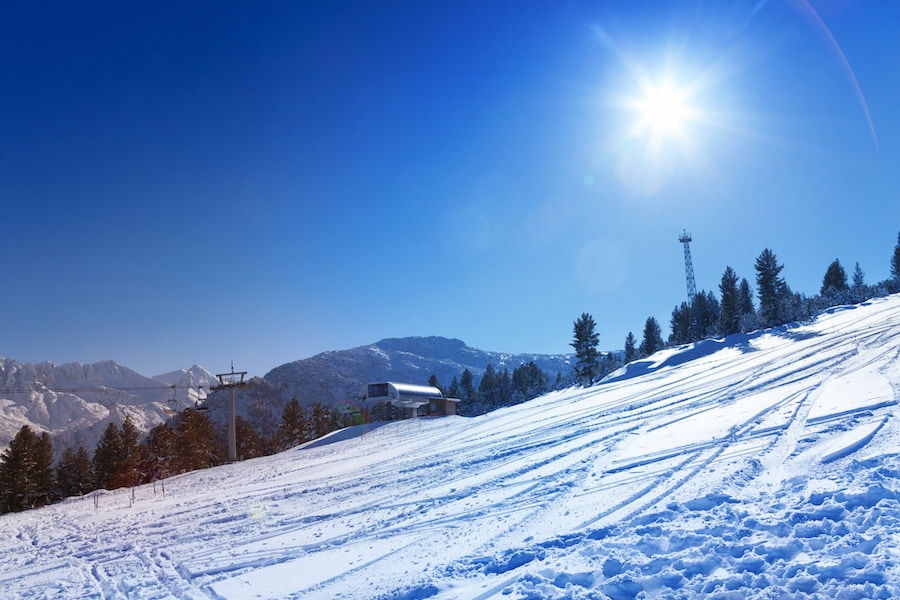
A 1 ½ hour drive south towards the Bulgarian/Greek border along the A3 and following signs to Bansko, located at the foothills of the Pirin mountains.
In recent years, the township of Bansko has become home to one of Bulgaria’s top tourist destinations for snow skiing and snowboarding. It’s also fast becoming one of Eastern Europe’s more popular ski resort locations.
As a ski resort location, Bansko is ideal during the winter; however, it is also a natural haven for outdoor hiking enthusiasts during the warmer months in the Pirin National Park.
Bansko’s location, nestled in the Razlog Valley, also provides an abundant supply of water reserves flowing from the many tributaries of the Mesta River and the pristine glacial lakes. You can also find plentiful options to enjoy the many hot springs and day spas in Bansko and the surrounding area.
For the history enthusiast, Bansko’s old town will not disappoint. The area’s rich and historical past has archaeological evidence showing that the Bansko and the Razlog Valley inhabitants date back to 100BC and periods of the Roman Empire.
Find yourself walking down the main pedestrian-only thoroughfare of Bansko Old Town and admire the unique architecture dotted between many stores and a very modern monument located in Vazrajdane square. The monument was built in honor of the Bulgarian philosopher Paisiy Hilendarski in 1976 and commemorated his ideas for national self-awareness and liberation from the Ottoman occupation.
As you continue past Vazrajdane square, you’ll notice a high enclosed wall surrounding a simple and well-maintained garden surrounding the church of “Sveta Troitsa” – Saint Trinity, a Bulgarian Orthodox Christian church.
The humble exterior can appear deceptive; however, step inside from the side entrance and feast your eyes on the ornate, colorful, and exquisite interior. Chandeliers light the interior and shine a golden glow on the gold-gilded frames housing icon images.
This humble church was built during Ottoman rule, taking nearly 45 years to complete both the church and the free-standing clock tower in the garden. The local church founders paid heavy taxes to the Ottoman rulers during this period, extending the church’s construction beyond normal.
There are many choices of traditional restaurants, known as mehana, in the old town. You’ll also find bars, cafés, many creperies, boutique clothing, and of course, many ski wear stores and traditional ceramic wares and souvenirs.
Exploring Sofia – The Capital Of Bulgaria On Day 5

There is just no way you can see all of Sofia in one day – so be sure to use day 5 to explore the parts you missed on your first day in the city.
Brands We Use And Trust
Extra Bulgarian Idea!
We’ve covered five days in Bulgaria, but if you have time and are in Bulgaria in June, check out the Rose Valley.
Rose Valley
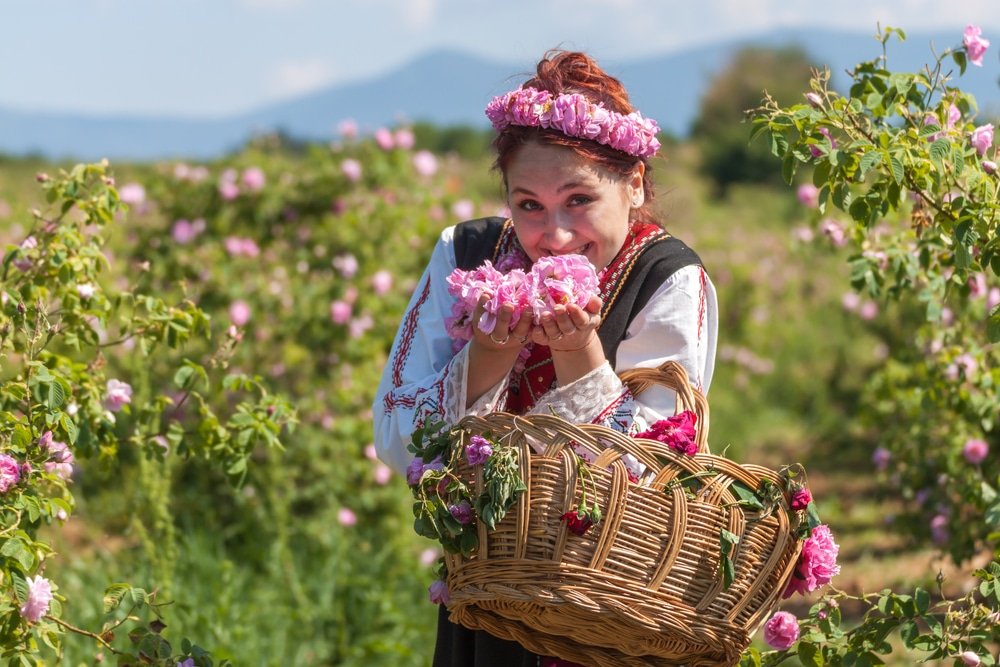
During the first weekend of June, the Central Bulgaria township of Kazanlak is blossoming with roses and the annual rose festival and harvest time are underway. The festival boasts a tradition of gathering roses early in the morning by people dressed in traditional clothing, with folk dancers, singers, and musicians performing in the rose fields.
Driving from Sofia to Kazanlak is approx. 2 ½ hours; however, be sure to visit the Damascena Ethnographic complex of Kazanlak, a short drive on the outer regions of the town center. Enjoy learning more about the production of pure organic rose essential oil. Experience the rose distillation process and the sweet scent of delicate Damascenaroses. Stop by the gift shop and buy yourself a gift to take home.
I trust you will enjoy your short 5-day stay experiencing Bulgaria’s capital – Sofia. Soaking up and admiring the city’s beauty, history, and blend of uniquely beautifully designed architecture. Along with sampling some of the regional highlights and treasures.
Move This Adventure To Your Inbox & Get An Instant Freebie

No spam. Unsubscribe at any time.
Best Time to Visit Bulgaria

The perfect Bulgaria trip depends a lot on timing. To catch Bulgaria at its best, aim for late spring (May to June) or early autumn (September to October). These months offer pleasant weather, fewer crowds, and the natural beauty of Bulgaria in full bloom or the golden hues of fall.
Summer is fantastic along the Black Sea coast if beach time is what you’re after.
But, if you’re keen on skiing in Bansko or exploring the cities without the chill, winter can be magical too. Each season has its charm, so think about what you want to see in Bulgaria and plan accordingly.
How to Get Around Bulgaria
Navigating Bulgaria can be part of the adventure. Hiring a car gives you the freedom to explore at your pace, perfect for those wanting to visit the best places scattered across the country.
For city hops, like from Sofia to Plovdiv, consider the well-connected buses – they’re affordable and offer a glimpse into everyday Bulgarian life. Within cities, public transport systems are usually reliable and easy to use, making it straightforward to see the best of what each city in Bulgaria has to offer.
Don’t shy away from using taxis for shorter distances; just make sure they’re metered.
Other Places to Visit in Bulgaria Worth Visiting
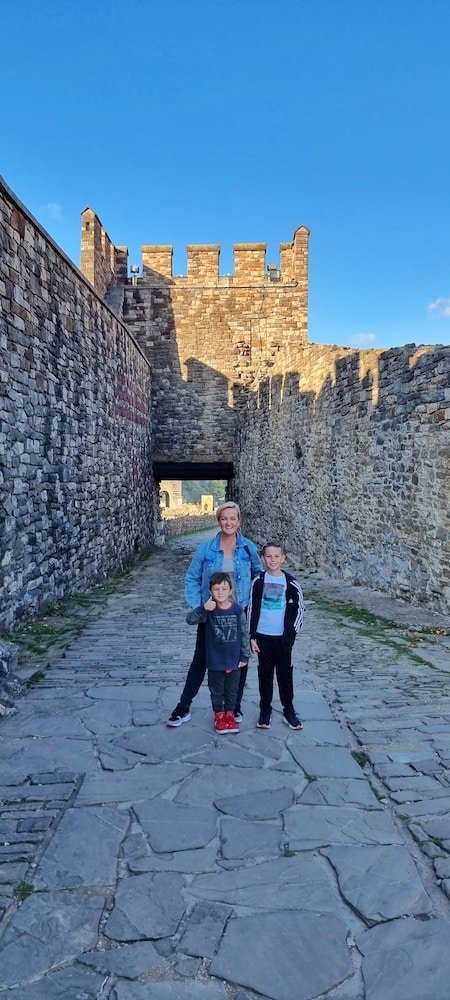
If your trip to Bulgaria extends beyond 5 days, you’re in for a treat. Beyond Sofia, Plovdiv, Rila Monastery, and Bansko, Bulgaria is teeming with hidden gems.
The Black Sea coast is lined with beautiful beaches and historical towns like Nesebar, while the interior boasts natural wonders like the Belogradchik Rocks. Veliko Tarnovo, the medieval capital of Bulgaria, offers a journey back in time with its fortress and panoramic views.
Each part of Bulgaria has something unique to offer, from ancient history to natural beauty, making it easy to fill your days by enjoying everything the country has to offer.
Whether you go on a day trip or decide to spend more time in one of these locations, you’ll find that Bulgaria is located perfectly for those who love a mix of cultural and natural attractions.
Find The Right Place To Stay In Bulgaria
- Things To Do In Sofia
- Things To Do In Varna On The Black Sea
- Best Day Trips If You Have Three Days In Sofia
- When Is The Best Time To Visit Bulgaria
- Why You Should Visit Shumen
- Rent A Car Bulgaria
- Where To Stay In Sofia
- Best All-Inclusive Hotels In Bulgaria
- Best Campsites In Bulgaria
- Where To Stay In Veliko Tarnovo


great overview, including where to eat. Thank u so much.